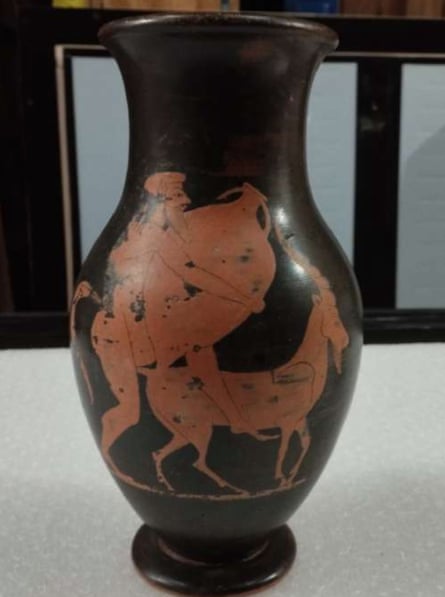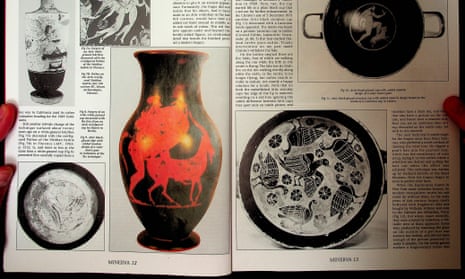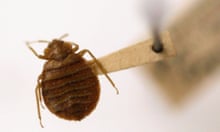Days after Greece announced the recovery of hundreds of antiquities from a disgraced British dealer, its ministry of culture faces the accusation that one of those artefacts, a vase of the early 5th-century BC, bears a decoration that is in fact a “modern forgery” created in the 1990s.
Christos Tsirogiannis, an archaeologist based in Cambridge, expressed astonishment that the ministry had included the olpe – a vase for wine – among treasured ancient objects that will be coming home.
He told the Guardian that if they had conducted adequate studies they would have known that it had been dismissed in 1998 by the foremost expert, among many examples of forged decorations on ancient vases – in this case, with an added modern design of a satyr and a goat.
Using worthless authentic materials to create a valuable fake is a typical technique used by forgers.
Tsirogiannis described the quality of the Greeks’ research as “absolutely shameful” because, in the announcement last Friday, Lina Mendoni, the Greek culture minister and an archaeologist, had claimed they had “worked systematically and methodically” on the collection, particularly over the past three years.

She announced on the official website that sculptures and vessels were among 351 objects that were being repatriated after a 17-year negotiation with the liquidated company of the antiquities dealer Robin Symes.
In 2005, Symes served a jail sentence for disregarding court orders over the sale of a £3m Egyptian statue, with the judge dismissing his explanation as “a calculated deception”. In 2016, Italian and Swiss police recovered marble statues, among other treasures stolen from Italy and allegedly stored by him at the Geneva Freeport in Switzerland.
after newsletter promotion
On Friday, the olpe was among antiquities listed by the Greek ministry of culture: “Attic red figure olpe with a decoration of a satyr carrying a large amphora. A goat appears in the background of the decoration. The decoration was made by the Six technique [one of the decorative techniques of ancient Greek vase painters]. Early 5th century BC.”
But, in 1998, the leading scholar Dietrich von Bothmer had published his findings on that same olpe, concluding that its decoration was a “modern forgery”.
In a wide-ranging study of forgeries of Greek vases, he wrote that its Six technique of added opaque colours on a black background was employed “five or six years” earlier than the article’s publication.
He argued that a satyr and a goat had been painted on an authentic black-glazed olpe “with a generous amount of flaking or abrasion to give it an ancient appearance”.
“Fortunately, the forger did not realise that his object, had it been made in an Attic workshop in [antiquity], would have had an added red band around its middle as its sole touch of colour. This red line now appears under and beyond the freshly added figures, an overlooked detail that brands the finished product a modern forgery.”
His article, published by the archaeology journal Minerva, was based on a paper presented in Basel, Switzerland, at the Fakes and Forgeries symposium in 1996.
Tsirogiannis said the ministry was apparently unaware of this. He said: “It is absolutely shameful because it exposes the real level of research, although they had 17 years to conduct that properly, and especially as the culture minister is herself an archaeologist. She is triumphantly including it as an early 5th-century vase because of the decoration. It’s mind-blowing, extremely embarrassing.”
Based in Cambridge, Tsirogiannis heads illicit antiquities trafficking research for the Unesco chair on threats to cultural heritage at the Ionian University in Corfu, Greece. Over 17 years, he has identified 1,664 looted objects within auction houses, commercial galleries, private collections and museums, alerting police authorities and governments and helping to repatriate items.
Last Friday’s announcement only included a small sample of the antiquities repatriated, he said: “We don’t know which other objects they have repatriated. Maybe there will be more unfortunate surprises.”
A spokesperson for the Greek ministry of culture and sports said: “Minister Mendoni cannot comment at the moment, as we are expecting a new minister to take over after last Sunday’s elections. However, a comment from the directorate of the ministry is that, in cases of recovery of illegally trafficked antiquities, any further research on them is carried out when the antiquities are back in Greek museums. Only then it is possible to study them thoroughly and, if required, to carry out laboratory analyses.”










